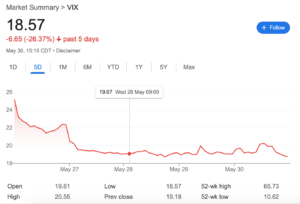Market Performance: A Strong May Rebound
- May 2025 witnessed a robust stock market recovery.
- Major indices surged significantly, erasing April’s losses.
- The S&P 500 notably climbed by 6.15%. This signaled renewed investor confidence.
- The Dow Jones Industrial Average rose 3.94%. Broader market sentiment improved.
- Nasdaq Composite led gains, soaring 9.56%. This strong rebound followed its sharp April decline.
- Russell 2000 also increased by 5.20%. These figures reflect a positive market shift.
- However, year-to-date performance remains mixed.
- S&P 500 is up slightly at 0.51%.
- Dow is down 0.64% year-to-date.
- Nasdaq has fallen 1% so far this year.
- Russell 2000 shows a 7.35% decline year-to-date.
Key Drivers of Last Week’s Rally (May 31, 2025)
Several factors fueled the recent market surge, easing investor concerns:
- Easing Trade Policy Worries:
- Trump’s delayed EU tariffs until July 9. This decision reduced immediate trade uncertainty.
- Market calmed over tax bill. The House-passed bill faces uncertain Senate approval in July.
- Improved Consumer Confidence:
- Conference Board Consumer Confidence rose to 98. This suggests resilient consumer sentiment.
- Robust Personal Income and Spending:
- U.S. personal income increased by 0.8%.
- Consumer spending also grew by 0.2%. These indicate healthy consumer activity.
- Signs of Inflation Cooling:
- Core inflation dropped to 2.4%.
- Headline inflation reached 2.1%. This nears the Fed’s 2% target, easing stagflation fears.
- Stable Bond Yields & Inflow:
- 10-year Treasury yield fell to 4.3%. Bond purchases increased, calming “sell America” fears.
- Rising Fed Rate Cut Expectations:
- September rate cut odds rose to 57.8%.
- Multiple cuts by year-end seem plausible. This offers hope for lower borrowing costs.
- Currency Market Stability:
- Dollar Index held around 99.
- Yen stabilized at 144 yen per dollar. This prevented further foreign exchange volatility.
- Ample Market Liquidity:
- Around $7 trillion is ready in MMFs. These funds could fuel further market gains.
- Strong Corporate Catalysts:
- NVIDIA’s stellar earnings and outlook. This boosted overall tech sector sentiment.
- Tesla’s upcoming robo-taxi announcement. This news added to market excitement.
Upcoming Headwinds and Potential Market Risks
Despite recent gains, several uncertainties persist, suggesting potential for bearish activity:
- Persistent Trade Tariff Unrest:
- Trump insists on re-imposing tariffs. This indicates continued trade policy aggression.
- China steel tariffs could surge to 50%. This threatens to escalate global trade tensions.
- U.S.-China Geneva agreement is straining. Disputes over rare earth and semiconductors persist.
- Resurfacing Geopolitical Tensions:
- Pentagon warns of potential China-Taiwan conflict. Calls for increased defense spending from allies are ongoing.
- This rhetoric heightens regional instability.
- Lingering Stagflation Concerns:
- JP Morgan CEO Jamie Dimon warns of stagflation.
- A 10-year yield below 4.25% could signal recession.
- U.S. National Debt Burden:
- Debt exceeds $35 trillion. This limits government’s ability to stimulate economy.
- Weakening Consumer Spending Signals:
- Durable goods orders have declined.
- Housing market activity is slowing. High mortgage rates (6.98%) contribute to this.
- Real GDP contracted by 0.2%. This raises recessionary alarms.
- Michigan Consumer Sentiment is near 2022 lows.
- One-year inflation expectations are still high at 6.5%.
- Market Technicals Show Caution:
- S&P 500 reached an overbought state. Potential for further correction exists.
- Put/Call options ratio is 0.70 (equilibrium).
- VIX stands at 18.57. This suggests potential for increased volatility.

- S&P 500 faces strong resistance at 5920. Failure to break this level could lead to a downturn.
Key Events for June 2025: What to Watch
June’s economic calendar will be crucial, shifting focus from earnings to macro data:
- Automobile Sales Data (Early June):
- May sales figures for Tesla, NIO, Ford, GM. These will indicate consumer demand.
- Critical Labor Market Reports:
- June 3 (Mon): ISM Manufacturing Index.
- June 4 (Tue): JOLTS Job Openings.
- June 5 (Wed): ADP Employment Report.
- June 6 (Thu): Weekly Jobless Claims.
- June 7 (Fri): Non-Farm Payrolls and Unemployment Rate. These reports are key for recession indicators.
- FOMC Meeting (June 18):
- Monetary policy guidance from the Federal Reserve. This will strongly influence market direction.
- “Triple Witching” Day (June 20):
- Increased market volatility is expected. This is due to options, futures, and index options expiration.
- Trade Tariff Decisions (Early July):
- July 9 deadline for EU tariffs. Ongoing trade policy will dominate headlines.
Strategic Approach: Navigating Volatility
- Strategic asset allocation is paramount.
- Adjust portfolios during market overheating.
- Be prepared for “dip buying” opportunities.
- Active management is key in uncertain times.
Disclaimer: This content is forinformational purposes only and does not constitute financial advice. Consult a qualified financial advisor before making investment decisions.Disclaimer: This content is for informational purposes only and does not constitute financial advice. Consult a qualified financial advisor before making investment decisions.
